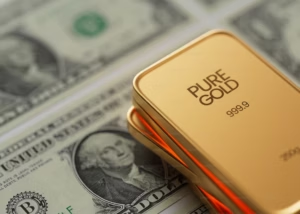Fed Report Reignites Talk of Gold Price Reset
Posted on — Leave a commentRemember the gold price reset talk from earlier this year? It’s back. In February, U.S. Treasury Secretary Scott Bessent said, “We’re going to monetize the asset side of the U.S. balance sheet,” which triggered a wave of speculation about what valuing gold at the current market price could mean. 
Now, a brand new Federal Reserve report issued on August 1 reignited that speculation.
You probably know the United States of America owns a huge amount of gold bullion—over 261 million troy ounces stored in vaults at Fort Knox, West Point, and the Denver Mint. Officially, our nation values our total gold reserve at around $11 billion. But, that’s at the 1930s official gold price of $42.22 an ounce—a far cry from the $3,300 an ounce at today’s market prices.
If the government marked our gold reserves at today’s market prices, suddenly our gold reserves would be worth around $861 billion. What if the government marked gold prices at $8,000 an ounce? Suddenly, our gold reserves are worth $2.1 trillion.
Why would the government do this? It’s a method to increase the federal balance sheet through an accounting adjustment – that suddenly creates new money for the government to spend, without outright money printing. Call it a technical accounting update, and presto, the government has more money on its books without raising taxes or cutting spending. This could be achieved fairly simply by Executive Order, no act of Congress needed.
One of the benefits of gold revaluation for the government is that it would instantly add money into the U.S. financial system without having to issue new Treasury bills, notes or bonds. For politicians struggling over the deficit, it would mean the Treasury has more money to pay the government’s bills, as the revaluation would, in a sense, create new money out of thin air.
The August Fed report, called: Official Reserve Revaluations: The International Experience reveals that economists at our nation’s central bank are seriously studying the gold price revaluation question.
“With public debt at high levels, some governments have begun to explore financing additional expenditures without raising taxes while also not increasing public debt outstanding,” the Fed report said. “One possibility is using proceeds from valuation gains on gold reserves, as has been floated in the U.S. and Belgium recently. For the U.S., this would involve revaluing the government’s 261.5 million troy ounces in gold reserves—the largest gold reserves globally— from a statutory price of $42.22 per troy ounce to current market prices, which stand around $3300 per troy ounce.”
In the research note, the Federal Reserve analyzes the five times in the past 30 years that nations revalued their gold and foreign exchange reserves to realize gains. This was done in Germany, Italy, Lebanon, Curacao and Saint Martin, and South Africa, the Fed said.
In one of the cases in Lebanon in December 2002, their central bank transferred unrealized profits on its gold and foreign exchange reserves to the central government. The proceeds were used to retire $1.8 billion of treasury bills, equivalent to around 11 percent of Lebanon’s GDP at the time.
While the Fed report doesn’t offer a conclusion, the study appears to reveal that the revaluation of even a significant portion of a country’s gold reserves delivers only a one-time boost to the balance sheet of either the central bank or the central government.
What could a revaluation mean for the price of gold? It would likely spike higher. Under Basel III, after the post-2008 reforms, monetary gold is now considered a Tier 1 asset, which means it is as good as cash on bank balance sheets. That means that a revalued gold price would also be a big boost and strengthen the banking sector’s capital positions.
A gold revaluation is expected to result in a further relative decline in the purchasing power of fiat currencies. Some on Wall Street warn this would be an inflationary move.
Will the government revalue gold? It’s an open question. With debt-to-GDP ratios climbing into uncharted territory, something will need to change. It’s just one more reason that central banks, wealthy individuals, family offices and pension funds are buying physical gold today—it’s the ultimate form of wealth protection.
Image by Planet Volumes








